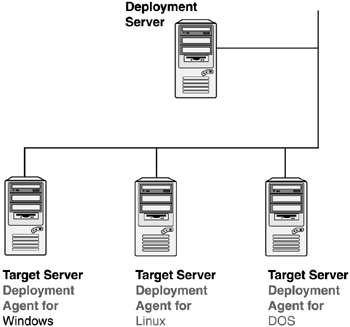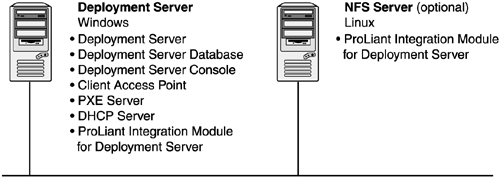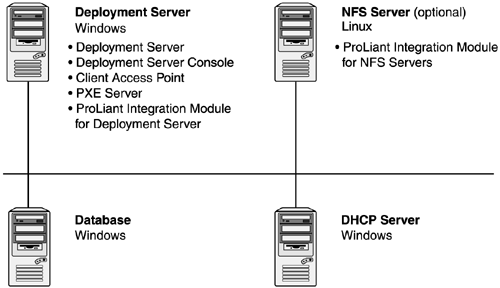RDP-Windows Edition Architecture
| < Day Day Up > |
RDP ”Windows Edition ArchitectureThere are two editions of the RDP:
note To deploy and manage Linux servers from the RDP ”Windows Edition requires a Linux server that is running the Network File System (NFS) Server with the ProLiant Integration Module for NFS Server installed. This Linux NFS server hosts the Linux installation files. The architecture of the RDP ”Windows Edition is a client-server design in which an agent runs on the client (the target or managed server) that enables the server (the Deployment Server) to gather inventory information and perform actions such as running scripts, changing the configuration, and rebooting. The Deployment Server is a Windows-based server. The target servers can either be new servers, Windows-based servers, or Linux-based servers. Server ComponentsThe RDP ”Windows Edition is a combination of the Altiris Deployment Solution and the HP ProLiant Integration Module. The Altiris Deployment Solution provides the foundation for deploying and managing supported servers. The HP ProLiant Integration Module provides ready-to-use ProLiant server deployment support. The following server components must be installed on one or more Windows-based servers: Deployment Server (Windows)
note The DHCP server component is required, but is not supplied by the RDP. Typically, an existing Windows DHCP server is used or DHCP can be installed on the Deployment Server. To support Linux scripted installs , the following server components must be installed on a Linux-based server that is running an NFS NFS Server (Linux)ProLiant Integration Module for NFS server Deployment ServerThe Deployment Server controls the flow of the work and information between the managed servers and the other server components. The managed servers connect and communicate with the Deployment Server to register their information. This information is stored in the Deployment Server database. Deployment Server DatabaseThe Deployment Server database maintains all the information about the managed servers, including hardware information, serial numbers , computer names , MAC and TCP/IP (Transmission Control Protocol/Internet Protocol) addresses, deployment history, and device information. Deployment Server ConsoleThe Deployment Server Console is a drag-and-drop GUI application that provides the main point of control. It enables you to
Client Access PointThe Client Access Point is a file share where the images, scripts, configuration files, tools, and software packages are stored. The space available on the Client Access Point must be large enough to accommodate all of the disk images and files. PXE ServerThe PXE server provides PXE clients with a boot image. The boot images use a Windows 9x DOS environment created from customer-supplied media. There are two boot images:
The PXE server assigns the correct image to the client without user intervention. DHCP ServerThe DHCP server provides clients with an IP address. The Altiris PXE server is designed to work with most DHCP servers, located either on the same server or on a different server. The Altiris PXE server has been optimized for use with the Microsoft DHCP server. ProLiant Integration Module for Deployment ServerThe ProLiant Integration Module for Deployment Server adds jobs, scripts, configuration files, the latest version of the ProLiant Support Packs (PSPs) for Windows, and the latest version of the SSSTK to the Altiris Deployment Solution. The provided deployment jobs deploy ProLiant servers by configuring the hardware and array controllers, installing the OS either by scripting or imaging, and then installing the latest version of the PSP. ProLiant Integration Module for NFS ServerThe ProLiant Integration Module for NFS server adds scripts, configuration files, and the latest version of the PSPs for Linux to an existing Linux-based NFS server. These files are required for the Linux scripted install jobs, which use an NFS-based installation mechanism. Client ComponentsThe Altiris Deployment Solution has three client programs:
Figure 9.8. Client agent components. Deployment Agents for Windows and LinuxThe Deployment Agents for Windows and Linux are installed on the production OS. The agents enable the Deployment Server to
Deployment Agent for DOSThe Deployment Agent for DOS is not installed on the production OS; instead, it's part of a specific DOS-based environment. This environment enables the Deployment Server to manage servers that do not have a production OS installed or must be disconnected from the production OS. The agent enables the Deployment Server to
Server Component Installation Optionswarning Before installing the Altiris PXE server component, a DHCP server must be installed, running, and accessible on the network. note When the Altiris PXE server is installed on the same server with Microsoft DHCP server, Altiris automatically configures the Option 60 setting in the DHCP options. If the DHCP server is not Microsoft, Option 60 must be manually configured with the value of PXECLIENT. There are two common installation options:
For complete installation requirements and directions, refer to the HP ProLiant Essentials RDP ”Windows Edition User Guide at http://www.hp.com/servers/rdp . Client Component Installation OptionsThere are two client component installation options, one for existing servers and one for new or unconfigured servers. Existing ServersFor Windows-based servers, you can install the Deployment Agent for Windows using either of the following methods :
For Linux-based servers, the Deployment Agent for Linux can be installed by manually installing the RPM on the target server. For complete directions, refer to the Altiris Deployment Solution Product Guide at http://www.altiris.com. New or Unconfigured ServersThe Deployment Agent for DOS is not installed, but the agent and DOS-based environment can be executed by any of the following methods:
|
| < Day Day Up > |
EAN: N/A
Pages: 214


